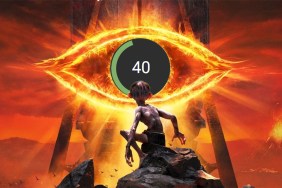Making it easy to rule them all.
Once upon a time, when I was less than Hobbit-sized, I would obsessively call the same burger joint day after day in a frenzy of anticipation over a particular Thunder Cats Ring of Power I had seen advertised on TV. I was convinced that, armed with this ring, I would be able to psychically communicate with anybody in the world, and more importantly, my eyes would turn red when I did it.
The ring didn’t work. It was of a nature fouler than Mumm-Ra‘s and viler than any perversion bred in the pits of Mordor. It was merchandise, reducer of mighty foes to candleholders and great heroes to lunchboxes. While we admit that merchandising probably isn’t the root of all evil, it has certainly taken its toll on Middle Earth in the form of lackluster titles like The Lord of the Rings: The Third Age.
 Despite some impressive preview showings, we feared more of the same from EA’s new The Lord of the Rings: The Battle for Middle Earth. But lucky for us (and you), EA’s new strategy take on Peter Jackson’s remakes was handled by the folks behind Command & Conquer: Generals. Now, Generals was by no means the best RTS of its day, and neither is The Battle for Middle Earth, but the latter improves upon many ideas introduced in the former while taking a fast-paced streamlined approach to RTS gaming. The result is a somewhat shallow, action-packed RTS that should appeal to casual PC gamers as well as Lord of the Rings fans.
Despite some impressive preview showings, we feared more of the same from EA’s new The Lord of the Rings: The Battle for Middle Earth. But lucky for us (and you), EA’s new strategy take on Peter Jackson’s remakes was handled by the folks behind Command & Conquer: Generals. Now, Generals was by no means the best RTS of its day, and neither is The Battle for Middle Earth, but the latter improves upon many ideas introduced in the former while taking a fast-paced streamlined approach to RTS gaming. The result is a somewhat shallow, action-packed RTS that should appeal to casual PC gamers as well as Lord of the Rings fans.
Provided, that is, they can get over the carelessly mishandled plot. For the most part, the story loosely unfolds during the battles. You’ll play through the mines of Moria as the Fellowship and defend Helm’s Deep from the army of Isengard, with a few set pieces and scattered sound-bytes along the way to remind you that you’re playing a Lord of the Rings game. Like other LotR titles based on the films, The Battle for Middle Earth feels more like a wax-museum tour than a game with its own soul.
Included is the ability to wage an evil campaign with the armies of Isengard and Mordor. There are no unique insights to be had here or exclusive communiqu’s between Sauron and Saruman about proper Orc breeding. Instead, you may take control of Sauron, Lurtz, and the Witch King himself! Right. Nothing ruins a character’s mystique like viewing his hit points and available spells.
It’s almost a shame that this game had to be saddled with the Middle Earth mythos, because it’s a solid RTS in its own right. Both the good and evil campaigns are nice and lengthy thanks to an open map and about thirty conquerable territories, while the intuitive online mode tracks some stats, provides a ranking, and can quickly match you with an evenly skilled opponent.
In both campaigns, you pick your battles from a beautifully rendered, 3D map of Middle Earth. Many realms and regions are named and briefly described, along with incredible visual touches like smoke rising from a perpetually eruptive Mount Doom, subtle sun-beams touching down through shifting mists, and eagles soaring about Caradharas. This map is a wonderful gift to Tolkien fans and puts everything from the books and movies into a new, gorgeous geographical perspective.
 In the early going, you will be forced to choose from among certain sets of battles to stay within the confines of the films’ progression. You must, for example, battle as the Rohirrim against the forces of Isengard for dominion over Rohan before you can skirmish with the Mordor Orcs and Haradrim in Osgiliath. Later on, the map opens up and you may attempt to take any territories you please before heading into Mordor for the final showdown.
In the early going, you will be forced to choose from among certain sets of battles to stay within the confines of the films’ progression. You must, for example, battle as the Rohirrim against the forces of Isengard for dominion over Rohan before you can skirmish with the Mordor Orcs and Haradrim in Osgiliath. Later on, the map opens up and you may attempt to take any territories you please before heading into Mordor for the final showdown.
But unlike the excellent Rome: Total War, there is nothing to micromanage on the over map nor any real strategy for conquering territories. Instead of cutting off enemy supply lines or bogarting a region’s iron production by capturing this or that mine, you just gain little bonuses for every zone conquered.
The benefits to taking a realm are listed underneath its name when you highlight it and are divided into three categories: resources, power, and command. For example, an area might say +30% resources, +2 power, and +30 command. This would mean that, in taking this field, you collect resources thirty-percent faster, get two more power points to spend on stuff in the magic tree, and your unit cap is increased by 30. Thanks to this weird, numerical system, conquest in The Battle for Middle Earth feels more like level-grinding than liberating or dominating a world.
The magic tree, a list of miracles you can buy with power points, doesn’t help matters. Once you buy a miracle you always have it and can use it at any time as long as its timer has refilled. Many of these grant your units some area of effect bonus, or summon allied units like Rohirrim or a nasty Balrog. Rather than have you save up power points to buy an undead army from the magic tree, the developers should have come up with something more immersive and less Final Fantasy.
Having said that, the experience system for units and heroes is awesome. As a unit or hero kills, it gains experience and eventually goes up in level. What’s more, you deal with the same armies throughout the game, so as you train and level units they persist and retain their experience so long as you keep them alive. To this end, you can name your units. When you’re looking for a throwaway cavalry unit to delay an oncoming rush, you’ll quickly be able to distinguish between important, named units and those you’ve just made.
 The action is fast-paced, squad-based and streamlined. Depending on the map, there are areas where camps, outposts, and castles can be built. Each structure involves a central tower, which must be erected before anything else. Once the tower is up, it is surrounded by circular build plots. Camps only get a few of these, while castles get several. When you left click on a plot it is encircled by various icons representing what may be built there. If you have enough gold (the only resource) to cover the cost, you simply click the desired structure and it is built.
The action is fast-paced, squad-based and streamlined. Depending on the map, there are areas where camps, outposts, and castles can be built. Each structure involves a central tower, which must be erected before anything else. Once the tower is up, it is surrounded by circular build plots. Camps only get a few of these, while castles get several. When you left click on a plot it is encircled by various icons representing what may be built there. If you have enough gold (the only resource) to cover the cost, you simply click the desired structure and it is built.
So erecting bases is a snap and takes moments. This is consistent with The Battle for Middle Earth‘s style in that you’re trying to spread quickly and throw up as many structures in as many areas as you can rather than holing up and waiting to die. Since a premium has been placed on speed, streamlining makes a lot of sense. However, completely axing free structure placement in favor of a “set it and forget it” scheme is like chopping off an arm to lose weight.
With its squad-based unit system (you make squads of units instead of individual ones), and victory point scheme, this game is somewhat up-to-date with titles like Ground Control II and Warhammer 40,000: Dawn of War. But where Battle for Middle Earth is more accessible than those two titles thanks to its streamlined approach, it isn’t nearly as innovative or entertaining. The unit depth isn’t there, the squads can’t be customized, and there are no formations to play with; advanced controls are absent. While fun, The Battle for Middle Earth is definitely strategy lite”
‘with some very heavy graphics. So heavy, in fact, that the engine occasionally buckles under the pressure. As the ostensible selling point, the thousand-unit, epic battles should be the most spectacular of all, visually. But once three hundred units start to melee on-screen, the framerate drops to about fifteen with the graphical quality set to medium on a bad ass computer.
 This is too bad, because otherwise The Battle for Middle Earth looks great. Every solider in every unit has its own physics, so when cavalry charge through a knot of infantry the bodies go flying. Eagles and Nazgul can drop down out of the sky, lift foes kicking and screaming into the air, and then drop them on their comrades, who are crushed by the impact.
This is too bad, because otherwise The Battle for Middle Earth looks great. Every solider in every unit has its own physics, so when cavalry charge through a knot of infantry the bodies go flying. Eagles and Nazgul can drop down out of the sky, lift foes kicking and screaming into the air, and then drop them on their comrades, who are crushed by the impact.
The sounds are yanked straight from the movies. Many of the films’ actors lent their voices and those who didn’t were replaced by excellent stand-ins. So excellent, in fact, that you wouldn’t even know they were stand-ins, so I’m not going to go and spoil anything for you. The plethora of sound effects is uniformly high in quality and lends an appropriately cinematic feel to this piece of movie merchandising.
The Lord of the Rings: The Battle for Middle Earth will not make you a part of the films any more than you were when you watched them, nor is it an RTS of incredibly epic scope. Instead, it is a solid, fun, slightly dumbed-down RTS that provides some good action even if it is inferior to three other recently released strategy games. It won’t make you grow cool spikes or turn your eyes red, but at least The Battle for Middle Earth is proof that there are fouler things in the dark places of the world than merchandise.
-
Fast actiní¢â‚¬â„¢
-
Good graphics
-
Map is almost worth admission
-
Streamlined
-
Dumbed-down
-
Power points and magic trees?
-
Chugs during big battles











